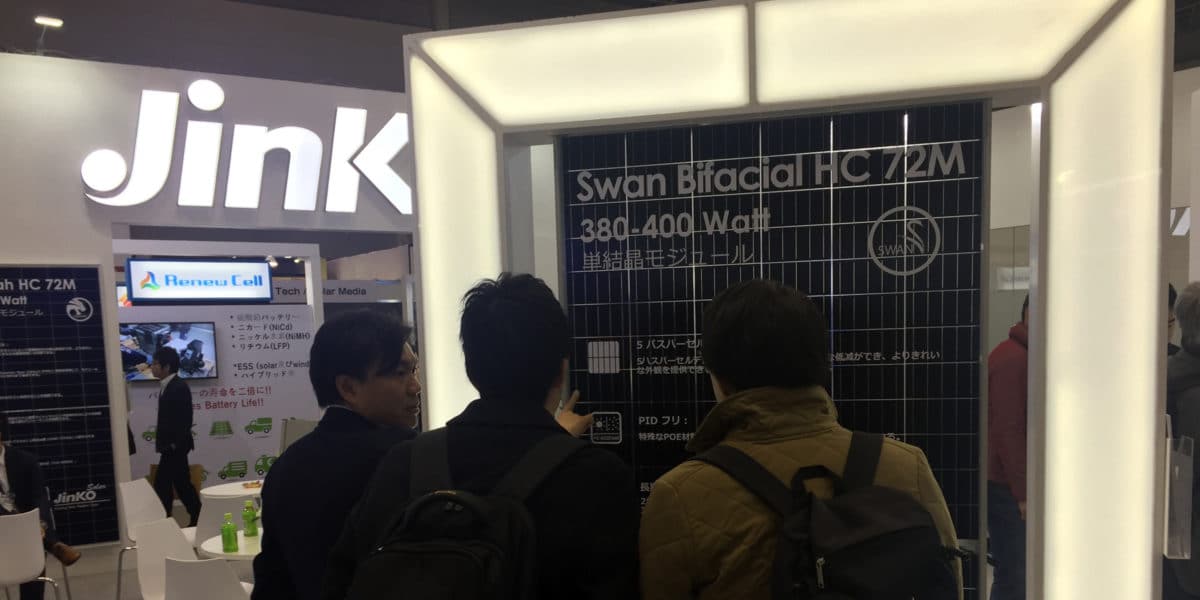A question begins to arise, if the cost of a clear bifacial is equal to that of a standard module – what’s the best backsheet? Sayno solar cells have long benefited from an opaque white backsheet feeding photons into the backside of their bifacial solar cells, and in our current solar module market we often see a 5 watt bump between the white backsheet versus the aesthetically pleasing black backsheets. How much does that compare to the random rooftops of the world?
JinkoSolar and DuPont have announced their new 400 watt “Swan” bifacial solar module. The product is based on the Jinko “Cheetah” solar cell line, and a clear version of Dupont’s Tedlar PVF backsheet film. The module has standard aluminum framing, and proclaims gains potentially greater than 20% more electricity generation versus mono-facial products in the best situations.
The module was unveiled at PV Expo in Japan. JinkoSolar has told pv magazine that the company is not yet making this module at its new factory in Jacksonville, Florida, but may do so in the future – although a product based on half-cut cells is first in line.
The companies suggested that using a clear backsheet will bring similar electricity generation gains as a standard glass on glass bifacial solar module. However, the levelized cost of electricity (LCOE) is projected to be lower due to this product fitting within the already standardized aluminum framed installation processes, keeping labor lower, as well due to the lower weight of aluminum frames versus the second piece of glass on the back.

The warranty of the clear backsheet product matches that of the standard backsheet products. Jinko and Dupont have been working together since at least 2015, and DuPont is the sole backsheet supplier to the Chinese PV maker.
It is clear that Dupont’s backsheet business stands to lose a lot if solar modules shift to a glass on glass structure, and the group is definitely aiming to educate the market that this is still a complex choice.
There is a chance though that a product like this makes it sensible for bifacial to be in all settings, instead of highly refined installation design parameters (surface albedo, row to row spacing, tilt, clearance, undergrowth, location, sky diffusion) that JinkoSolar suggests consideration of to maximize bifacial reflection.

These tuned variables drive the greatest gains from a solar power system, and the most advanced project developers will maximize them. However, if the bifacial with backsheet process matches prices and installation techniques for monofacial products, it opens new doors.
For instance, aesthetics drive customer demand for the black (cells) on black (backsheet) on black (frame) product offerings that cost more and have a lower efficiency. How will the tastes of consumers react to a black frame, black cells, and a sprinkling of the coloring of their own rooftop peeking through versus the black backsheet?
Commercial customers won’t care, so if any benefit comes from these in non-optimized installation conditions (tight against roof, 5-15 degree angles, very tight installation rows) they could become the de facto product. This could be a real value on top of white rooftops that are the fashion in commercial settings.
These answers will come as engineers and developers at the largest installation shops get extended data from projects deployed, and with this product from Dupont, expect it to be a simple test without much risk.
This content is protected by copyright and may not be reused. If you want to cooperate with us and would like to reuse some of our content, please contact: editors@pv-magazine.com.








By submitting this form you agree to pv magazine using your data for the purposes of publishing your comment.
Your personal data will only be disclosed or otherwise transmitted to third parties for the purposes of spam filtering or if this is necessary for technical maintenance of the website. Any other transfer to third parties will not take place unless this is justified on the basis of applicable data protection regulations or if pv magazine is legally obliged to do so.
You may revoke this consent at any time with effect for the future, in which case your personal data will be deleted immediately. Otherwise, your data will be deleted if pv magazine has processed your request or the purpose of data storage is fulfilled.
Further information on data privacy can be found in our Data Protection Policy.